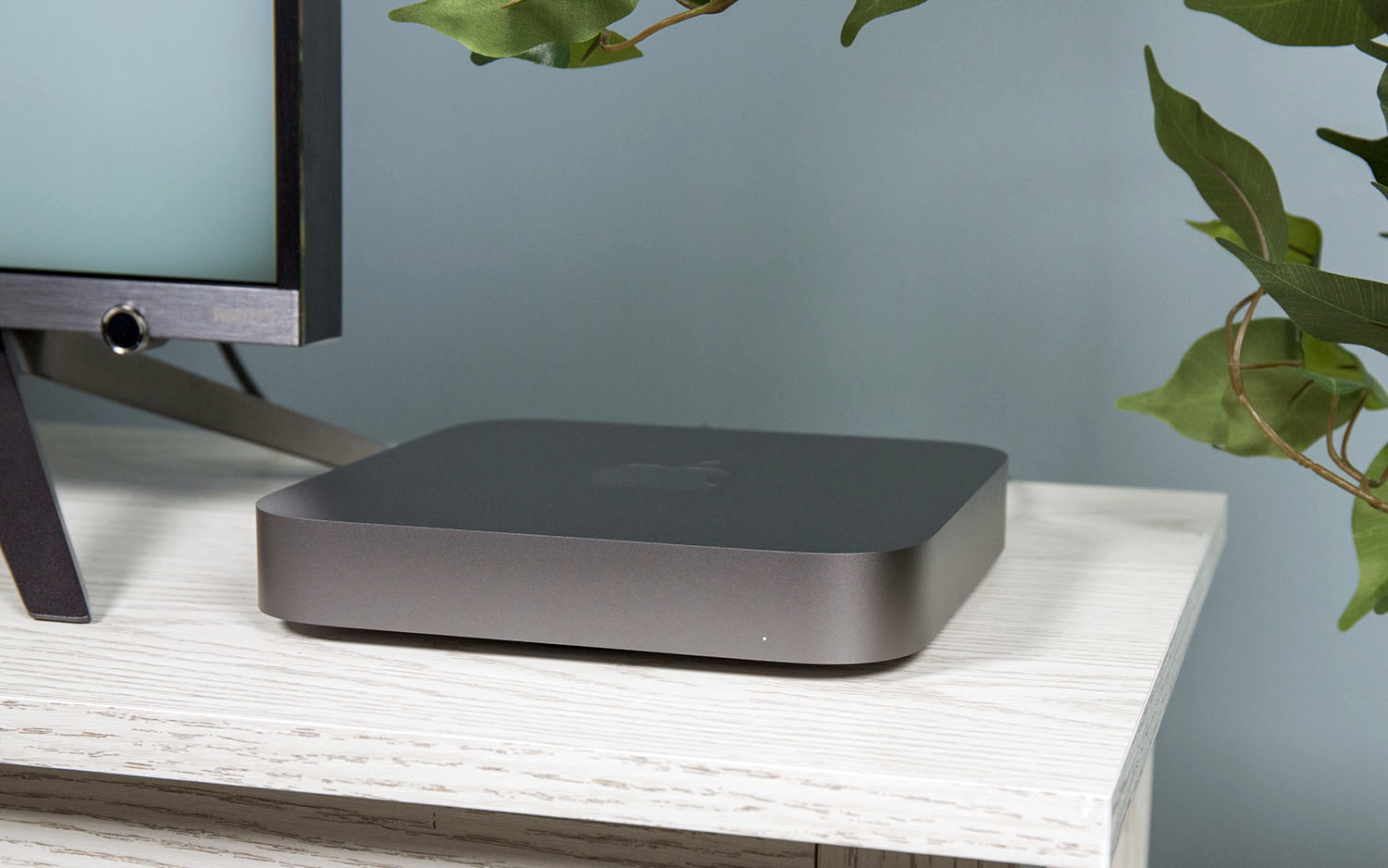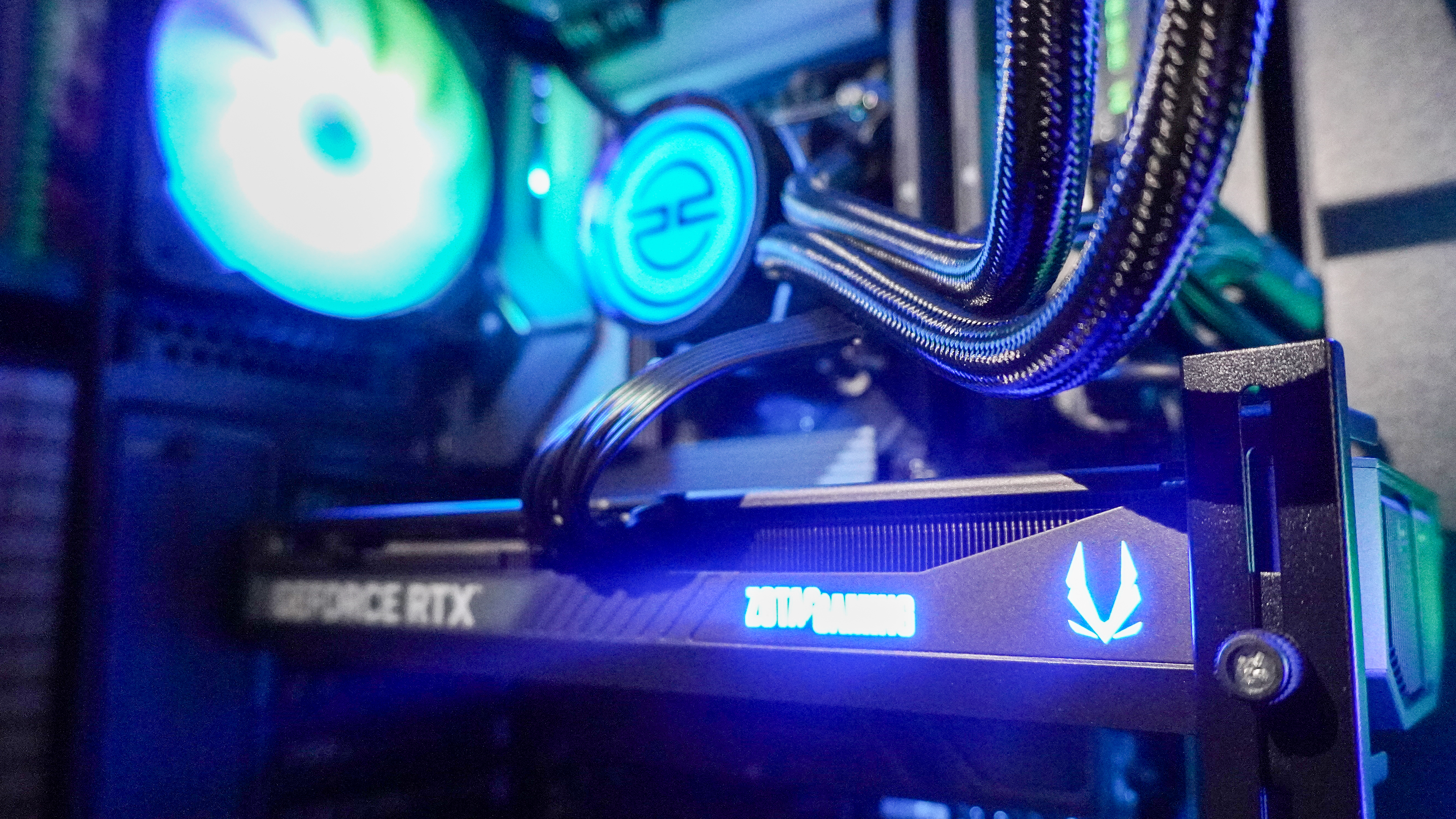Tom's Guide Verdict
The Apple Mac mini (2018 model) is finally back, and it's better than ever, with a new look, rock-solid performance, and even a bit of upgradability. It's not just the best (and only) mini PC in the Mac lineup, it's also one of the best mini PCs we've seen.
Pros
- +
Same compact dimensions with a space-gray finish
- +
Upgradable RAM
- +
Four Thunderbolt 3 ports
- +
Healthy 4K display support
- +
Impressive performance
- +
Improved Mac OS Mojave
Cons
- -
Limited upgradability
- -
Very limited internal access
- -
Can get pricey
Why you can trust Tom's Guide
After four long years, Apple has finally brought the Mac mini back to life with a 2018 update that just might have been worth the wait. The Mac mini 2018 ($799 as tested) gets a full refresh with a new look, a new internal design and new hardware tuned to provide excellent performance. It's one of the best mini PCs you can buy, and the best value Mac offers today.
Editor's Note: (March 18, 2020) Apple has updated the Mac mini, doubling the storage offered on the basic configurations. Since other hardware remains the same, we expect performance to be relatively unchanged.
Apple Mac mini review: Design
The Mac mini has had the same dimensions for the better part of a decade, when the unibody Mac mini was introduced in 2010, with its 7.7 x 7.7 x 1.4-inch design. It's kept those same dimensions in 2012 (when it dropped the built-in optical drive) and again in 2014. Now, in 2018, the new Mac mini has the same dimensions, and weighs a svelte 2.6 pounds.
- Protect your new Apple kit with the best Mac VPN
That small size was impressive several years ago, but current mini PCs have drastically smaller sizes – the Azulle Access Plus is a svelte stick PC and the recently reviewed Zotac ZBox PI2250 pico isn't much bigger than a credit card. The Mac mini's 7.7-inch square design isn't terribly different from the HP Z2 Mini G4 and the Lenovo ThinkCentre M710q Tiny, but the unibody design still looks sleek.
But the littlest Mac has gotten a pretty stunning makeover, starting with the space-gray anodized finish. The darker finish makes the bare-metal design look much more modern – the bright aluminum of past Apple designs looks decidedly early 2010 now – and matches the finish found on the iMac Pro and Macbook Pro lines. It's also more environmentally responsible, with the entire aluminum body made from recycled material.
The littlest Mac has gotten a pretty stunning makeover, starting with the space-gray anodized finish.
To accommodate the updated hardware inside, Apple had to change some of the internal design, as well. The design has larger vents and a bigger fan, doubling the airflow to better cool the processor. The power supply has been enlarged to provide the necessary power to the new components.
On the bottom of the Mac mini's aluminum chassis is a black plastic disk, which does double duty as both the foot for the compact PC as well as a cover that opens to provide internal access. Around the edges of the panel are cleverly concealed vents for air flow, and the simple black surface has "Mac mini" imprinted on it.
This access panel has taken different forms over the last few iterations of the mini, with the 2010 model offering a simple twist-to-open design and the 2014 model requiring a special prying tool (literally, a modified putty knife) to open. Unfortunately, the 2018 model still uses the less convenient design that requires a special tool.
Apple Mac mini review: Upgradability
The Mac mini is being touted as more upgrade-friendly than the previous model, which had its RAM soldered directly to the motherboard. The 2018 model offers more traditional SO-DIMM slots, so you can swap out RAM, allowing you to upgrade the unit after purchase. It also means you'll be better able to keep the Mac mini up to date if Apple takes another four-year break before introducing the next model.
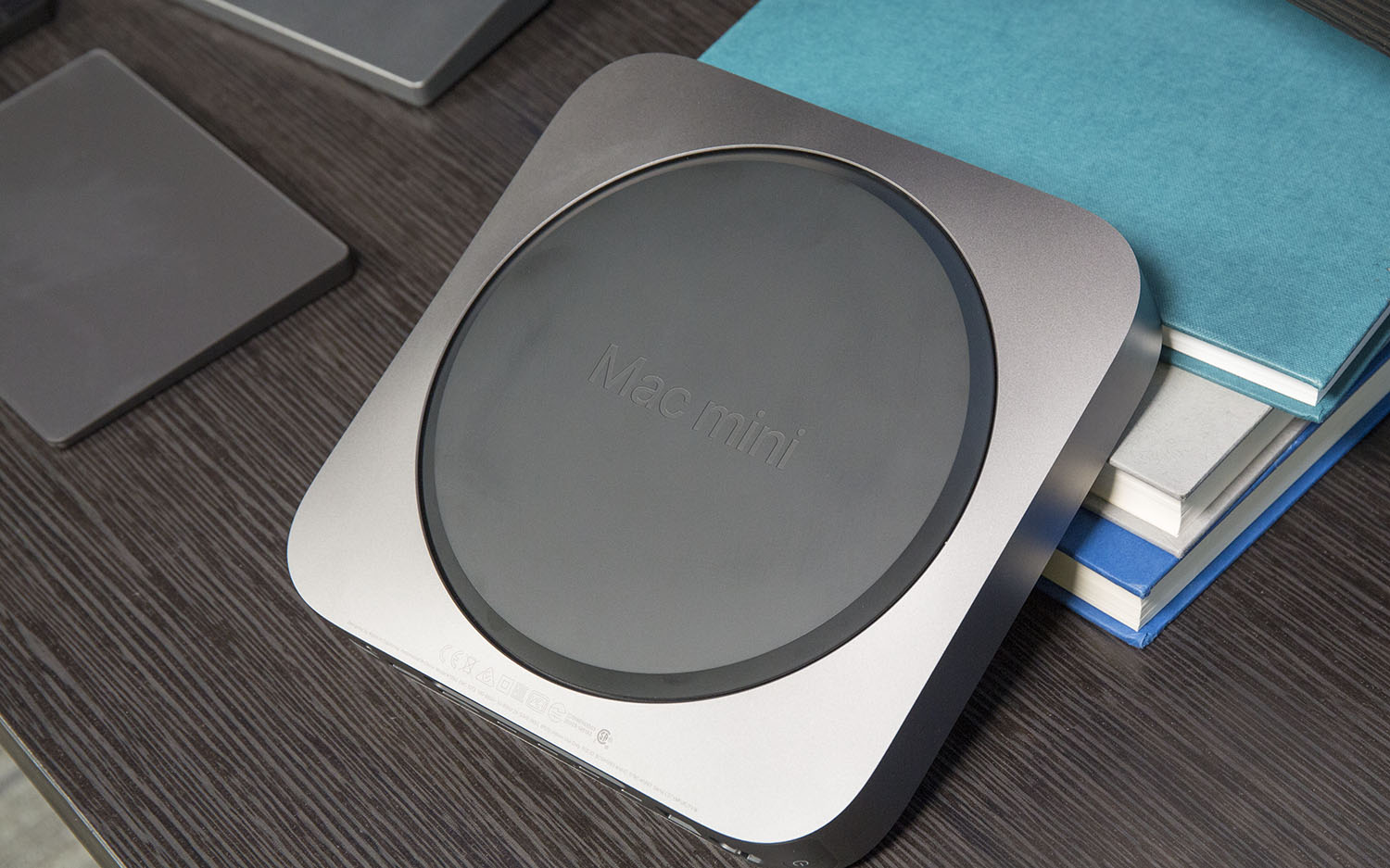
Accessing the internals of the system is difficult. Apple has a well-deserved reputation for making its products hard to upgrade, and the Mac mini is no exception. In a discussion with Apple representatives, it was explained that the Mac mini was meant to be "service upgradable" – upgradable by professionals at a Genius Bar or other approved Apple service provider – rather than "user upgradable."
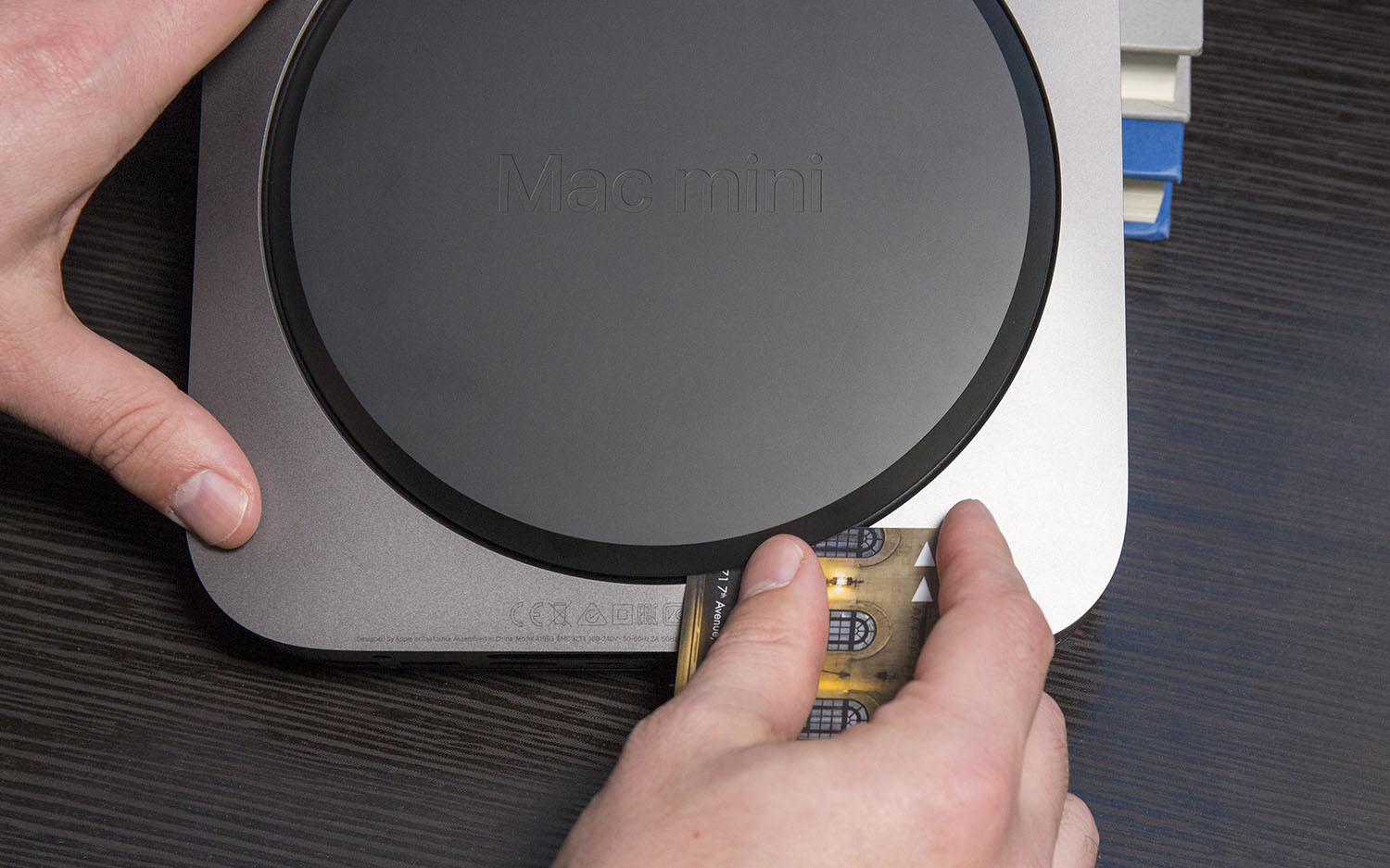
The access panel has to be removed with a special tool, likely the same modified putty knife used in the previous model (we got a credit card to work). Once you open the access panel you will be faced with a metal grille secured with six Torx screws. Just to make things a little more irritating, a standard Torx driver set is not compatible with these screws, which feature a center pin inside the recessed driver slot of the screw.
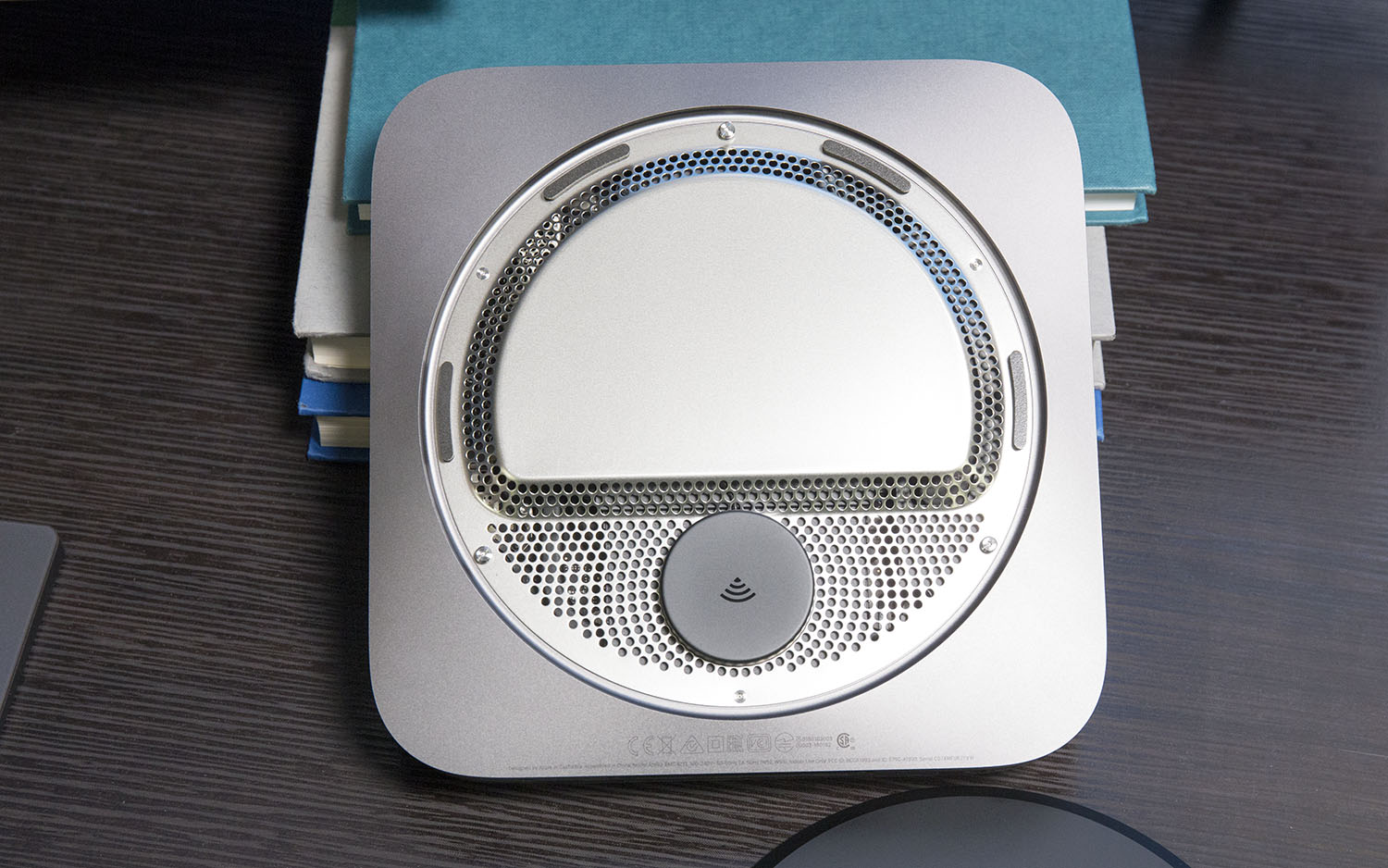
So, even if you have a set of tiny Torx drivers, you'll probably need to get a different screwdriver, one with a hole in the center to accommodate that pin. Specifically, you'll need a driver for a TR6 Torx security screw.
Additionally, while Apple has returned the upgradable RAM found on the 2010 and 2012 Mac mini, the upgradable storage is gone.
In the 2014 model, you could remove the included Fusion drive (Apple's hybrid SSD and hard-disk storage solution) and replace it with an aftermarket SSD, boosting the performance of the machine and extending the life of the Mac mini – which many people found necessary in the long wait for this year's update. In the 2018 model, that option is gone. The PCIe-connected SSD is soldered to the logic board, making the flash storage modules all but impossible to remove and replace.
Apple has a well-deserved reputation for making its products hard to upgrade, and the Mac mini is no exception.
The good news is that, thanks to the bandwidth offered by the Thunderbolt 3 ports found on the rear panel of the system, you can connect external storage – even at jaw-dropping capacities – and use it without taking a hit on performance.
Similarly, while there's no configuration for the Mac mini that offers a discrete graphics card, you can also bump up the horsepower for gaming and other graphics-intensive uses by adding an external graphics card enclosure, also connected via Thunderbolt 3.
Apple Mac mini review: Ports
On the back of the mini, you'll find four Thunderbolt 3 ports (using USB Type-C connections), two USB 3.0 ports, a single HDMI 2.0 port, a headphone jack for audio and a Gigabit Ethernet port.
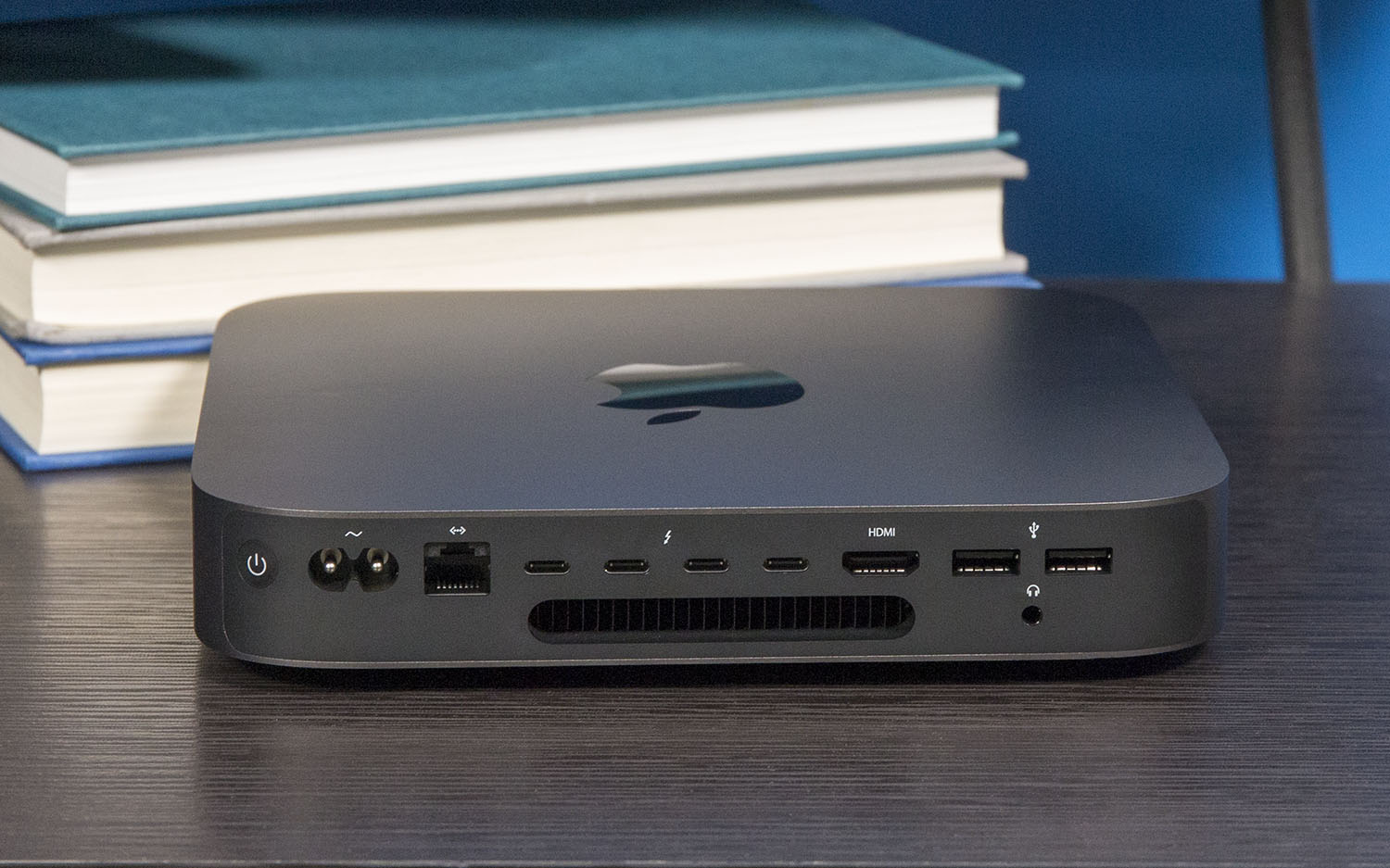
Those Thunderbolt 3 ports offer a huge amount of connectivity, thanks to speeds of up to 40Gbps. It's enough to connect two 4K displays, and you can also use an external GPU, not to mention all manner of storage and peripherals.
If you need even more speed for connecting a local network or network-attached storage, the Ethernet port can actually be configured as a 10 Gigabit connection, instead. It's a very cool business-friendly feature that media pros will appreciate, but won't be much use to the average user.
And, it wouldn't be Apple without dropping a connection or two. While you get more connectivity overall with the new Mac mini, you do lose the SDXC card slot from the 2014 model. To use an SD card on the new model, you'll need to connect an adapter via USB 3.0 or Thunderbolt 3 port.
Apple Mac mini review: Performance
Every configuration of the Mac mini is outfitted with quad-core Intel 8th-generation processors and all flash storage. Apple has been promoting the dramatic improvements in performance from the previous Mac mini, but those claims ring a little hollow when you consider that the last Mac mini update was in 2014, and that the previous system was still rocking fourth-generation dual-core processors.
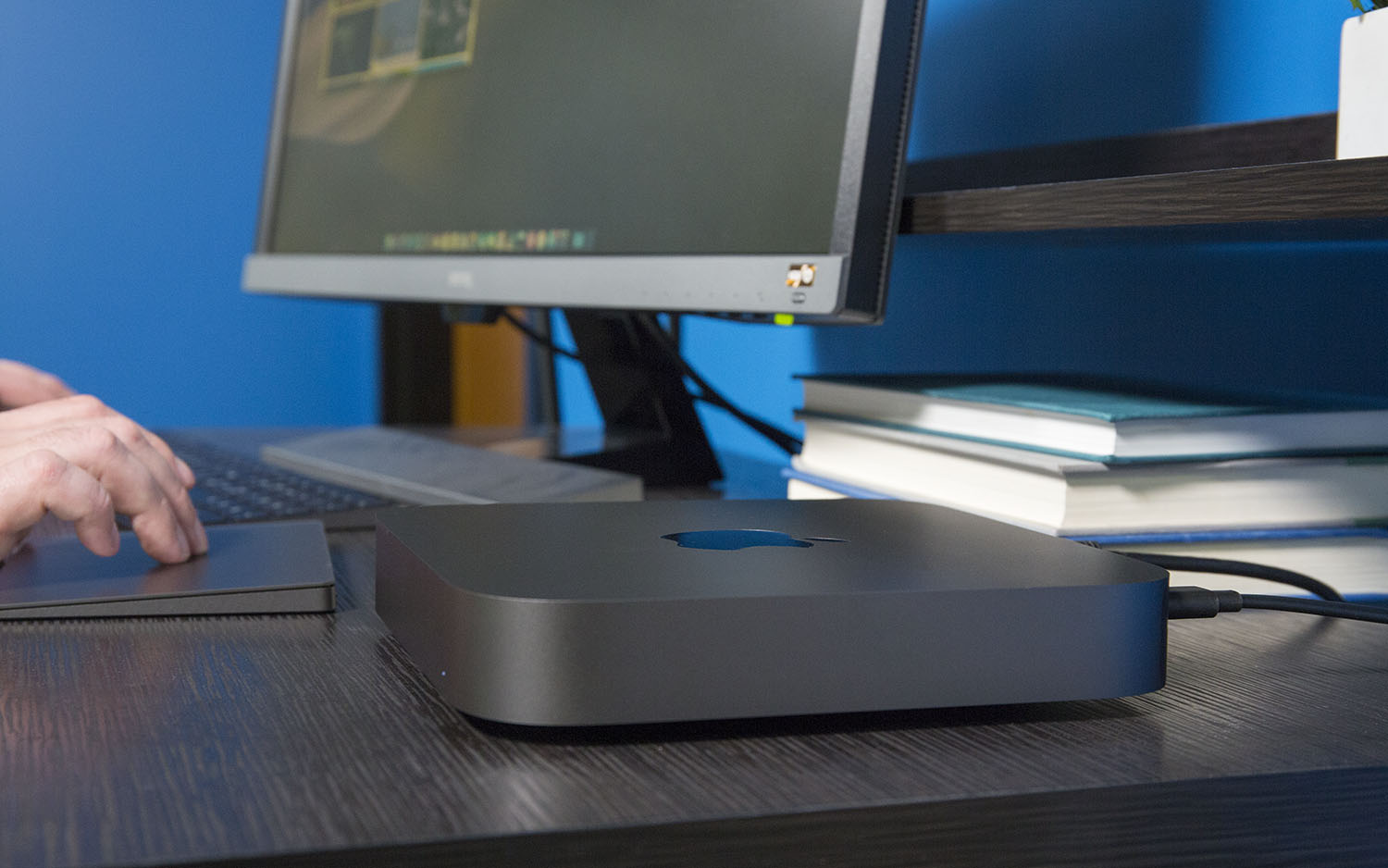
Our review unit is the base model, which comes with an Intel Core i3-8100B processor, 8GB of memory and 128GB of SSD storage. During usage, I saw plenty to like. When web browsing, I could browse with 15 tabs open, while also streaming music and video. I never experienced any lag.
Apple also has added to the Mac mini the same T2 security chip that comes in its new MacBooks, including the new MacBook Air. This chip serves as a co-processor, providing secure boot capability and full disk encryption.
Apple also boasts that the T2 allows faster video transcoding, claiming up to 30 times faster HEVC video encoding than the 2014 model was able to offer.
Whenever we test a Mac, we're limited because several of our standard tests are not Mac-OS-compatible. However, in the tests we were able to run, we saw some excellent performance from the Core i3 Mac mini.
File transfer speeds were fast enough that I did a double take. I took 2 seconds to copy over our 4.97GB file folder, which works out to a 2,544 MBps transfer rate. That's significantly faster than the HP Z2 Mini G4 (1,017.8 MBps), which is something of a speed demon in its own right. It's exponentially faster than other mini PCs, like the Intel Hades Canyon NUC (310.60 MBps) or the Lenovo ThinkCentre M710q Tiny (169 MBps). In fact, it's identical to another member of the Mac family, the workstation iMac Pro, which had the same 2 second, 2,544 MBps speeds.
File transfer speeds were fast enough that I did a double take.
Processing performance was nowhere near as dramatic, but it's still fairly impressive coming from an Intel Core i3 CPU. In Geekbench 4, the Mac Mini managed a score of 13,666 points.
While that's no match for the beefy HP Z2 Mini G4 workstation (23,921 with an Intel Xeon E-2176G processor, 32GB of memory) or the Intel Hades Canyon NUC (17,683 with an Intel Core i7-8809G and 8GB of RAM), it's a big step up from the Lenovo ThinkCentre M710q, which scored 8,010 points with ostensibly better hardware (Intel Core i5-7500T, 8GB RAM).
Running the JetStream 1.1 benchmark to see how it performs with web apps, the Mac mini dominated with a score of 281.84. That's phenomenal for a Core i3-based system. The Core i5-based Lenovo ThinkCentre M710q Tiny scored only 154.58 on the same test, and even the Xeon-powered HP Z2 Mini G4 workstation scored only 193.40.
MORE: Best Mini PC - Small Computers for Work, Gaming ...
If you plan to use the Mac mini as a home theater PC for streaming to a TV, or as a basic productivity machine that uses web apps heavily, you'll be set with one of the best mini PCs on the market, even in this basic configuration.
Apple Mac mini review: Cooling
With its Intel Core i3 processor in a small metal enclosure, I expected that the Mac mini’s case would get hot when it was put through its paces. I was wrong.
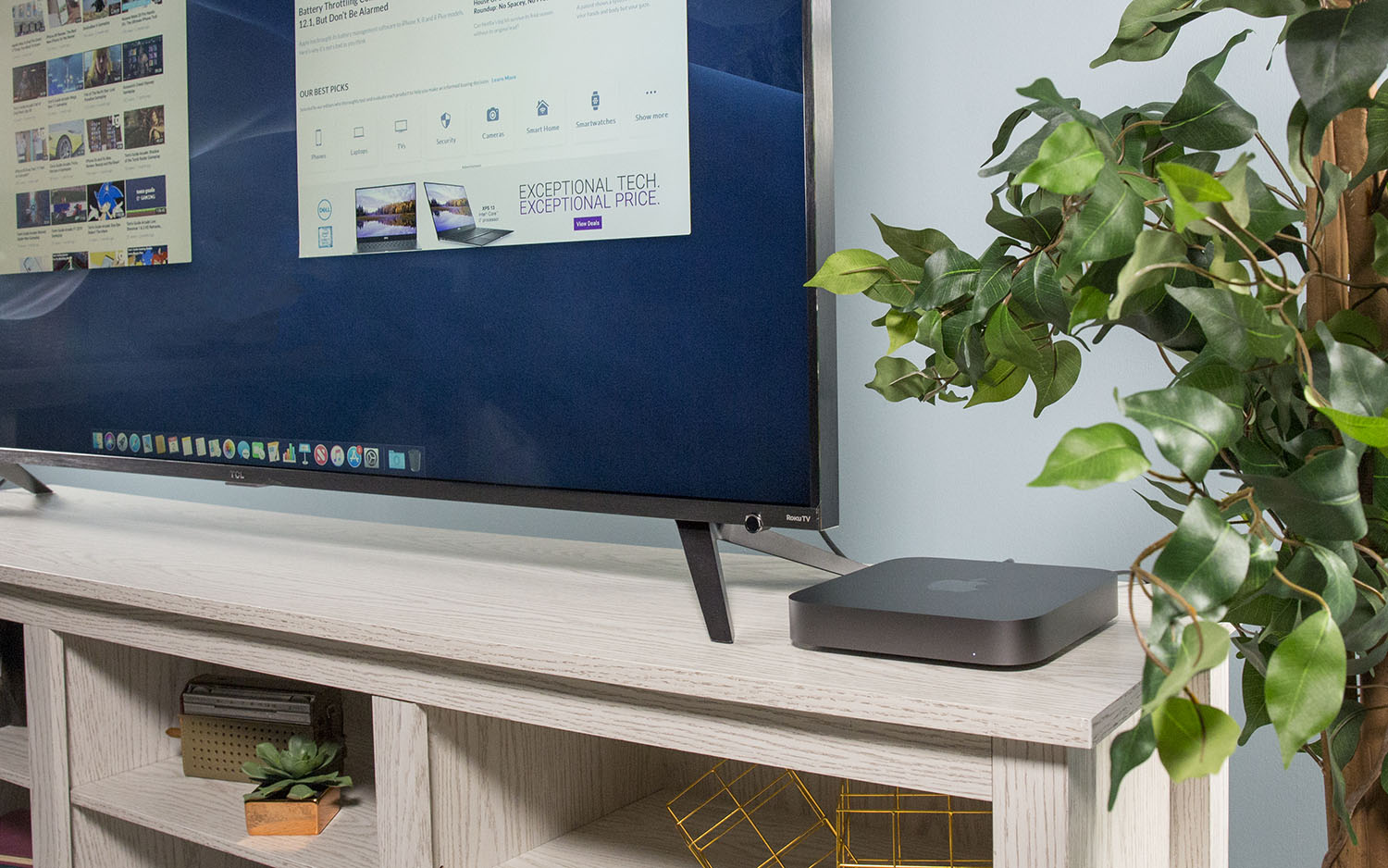
Even after I streamed video, ran benchmark tests and used the system to work on this review, the Mac mini never got warmer than 85 degrees Fahrenheit, which is only 15 degrees above the room temperature of our lab. That's barely enough heat for it to feel warm to the touch.
It's well below the 95-degree comfort threshold we hold laptops to, and it's significantly cooler than the HP Z2 Mini G4 (94 degrees). Compared with smaller, less powerful mini PCs, like the Zotac Zbox PI225 pico, which hit 126 degrees during testing, and there's no comparison. The Mac mini is one cool customer.
Even after I streamed video, ran benchmark tests, and used the system to work on this review, the Mac mini never got warmer than 85 degrees.
It's also quiet. The Mac mini's larger fan lets it run slowly and silently, while still providing enough airflow for cooling. That's good news for audio pros and home-theater users alike, since it means you won't have to contend with a noisy computer when you're trying to get clear audio.
Apple Mac mini review: Software and warranty
The 2018 Mac mini ships with macOS version 10.14 Mojave, Apple's latest operating system. Some of Mojave’s key new features include a night mode, which offers a darker color scheme; deeper integration with iPhone and iPad, improvements to Finder, including Gallery View; and an automatic desktop organization tool called Stacks; it even brings some iOS apps over to the desktop. See our full review of Mac OS Mojave for a more detailed look at the operating system, but suffice it to say, it's a decent step forward for the much loved Mac OS.
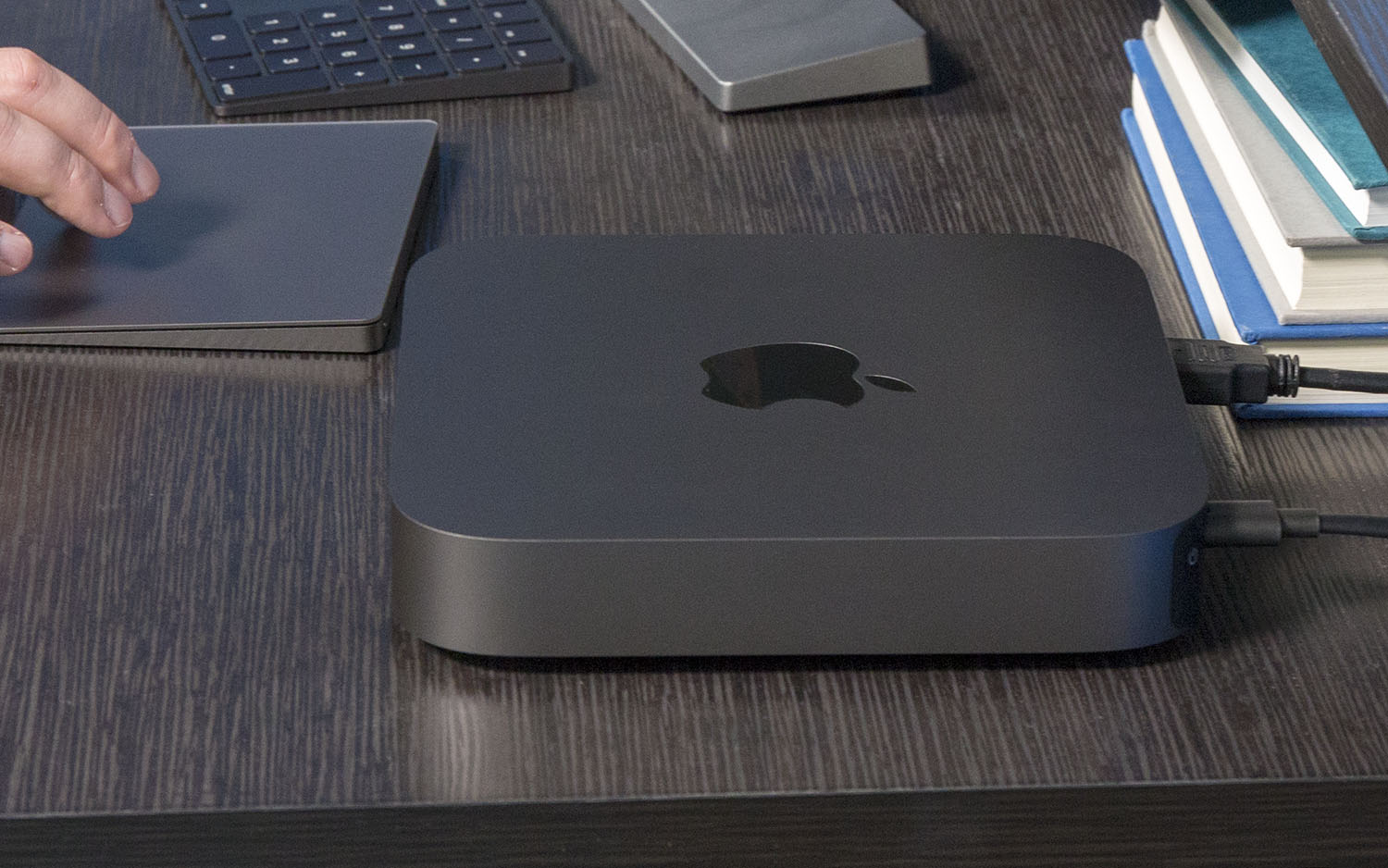
Mojave comes with a full office suite (Pages, Numbers and Keynote, the Mac equivalents of Word, Excel and PowerPoint), as well as Photos, iMovie, GarageBand, the Safari web browser and a rich selection of apps. Some of the iOS apps to come to the Mac include Stocks and Voice Memos. You'll also get Siri, but without the built-in microphones found on other Macs, you won't be able to use the "Hey, Siri" functionality you may be used to from other Apple devices.
The Mac mini is covered with a one-year warranty, which includes hardware repairs through authorized Apple service providers. Included with the new Mac is 90 days of free phone support. With our top rating for tech support, it's hard to complain.
MORE: Mini PCs - Reviews, News and Our Top Picks
You can also get AppleCare for an extended three-year warranty, which gives you both repair service and technical support. But it should be noted that, if the previous model is any indicator, those three years of coverage may not stretch far enough to keep you covered until a new model comes along. If you bought a Mac mini in the first few months after release, you would also have spent up to a year with no warranty coverage while waiting for this model to be announced.
Apple Mac mini review: Keyboard and mouse
While the Mac mini is generally sold on its own – the package contents are literally the Mac mini, a power cord and some documentation – Apple included with our test unit the space- gray keyboard and trackpad. That's about $300 worth of extra stuff that you'll have to purchase separately, but that matches both the space-gray Apple aesthetic and the capabilities of the Mac and Mac OS.
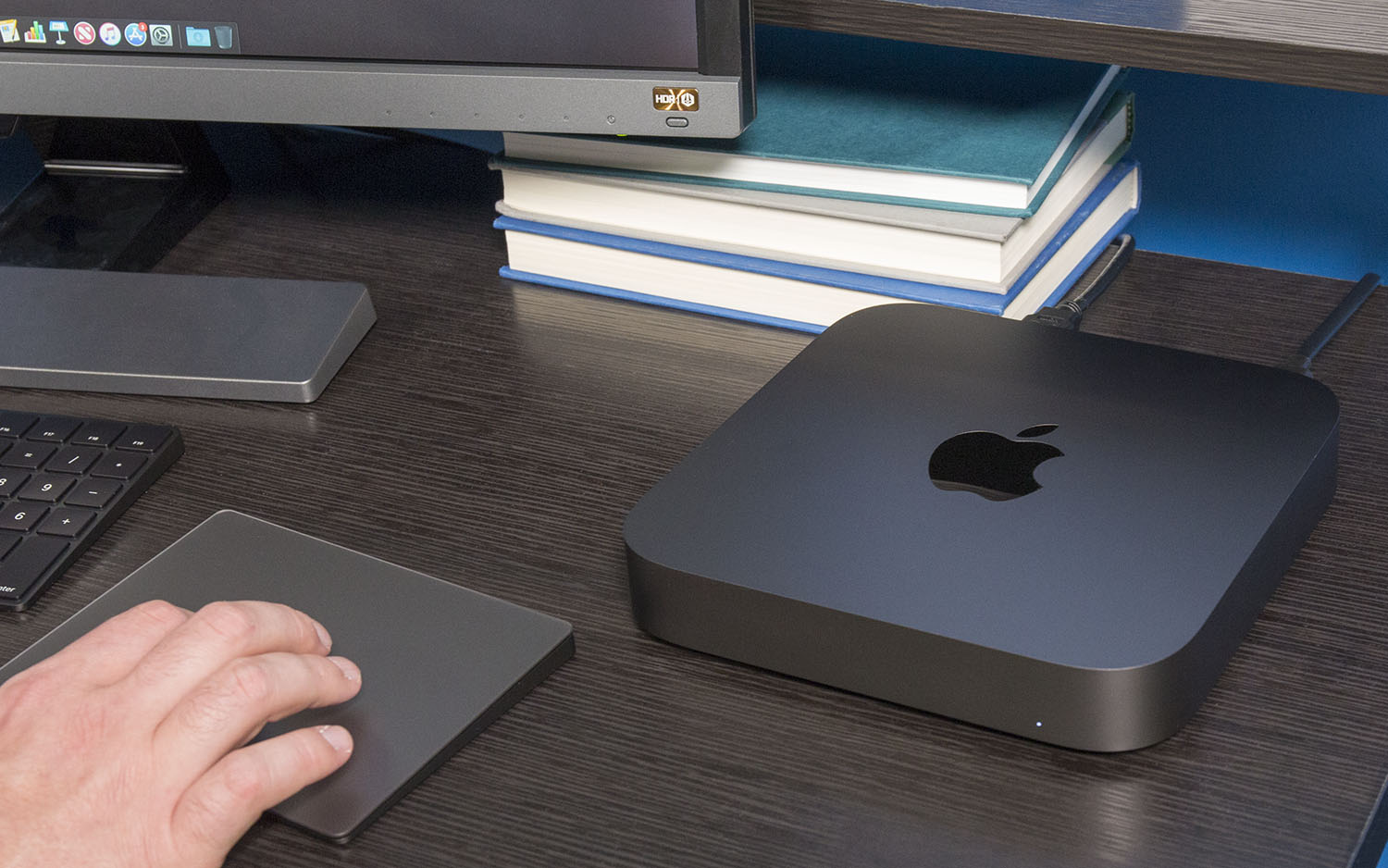
The keyboard, technically called the Magic Keyboard with Numeric Keypad ($149), is a slim wireless keyboard that uses rubber dome/scissor switches for a low-profile design that still offers a decent typing experience with good tactile feedback. It's no mechanical keyboard, but it's still comfortable to type on.
The trackpad that Apple sent, the Magic Trackpad 2 ($149) in space gray, is also a welcome addition, since it not only offers a sleek trackpad to go with your Mac mini, but also boasts additional pressure sensitivity for Apple's dynamic Force Touch.
This lets you enjoy all of the unique contextual menus and expanded functionality that you'd get on a Macbook in the desktop environment. It's a must-have for media creators who need all of the tools and shortcuts that take advantage of Force Touch, but it's worth considering even for the regular user who might be used to those same dynamic controls from their Macbook Pro.
Apple Mac mini review: Configurations
The Mac mini comes in two primary configurations. Our test unit is the base model, which is equipped with a quad-core 3.6GHz Intel Core i3 processor, 8GB of 2666MHz DDR4 RAM and 128GB of flash storage, and sells for $799. (Ed. Note: Apple has since changed the base model to 256GB of storage at the same price.)
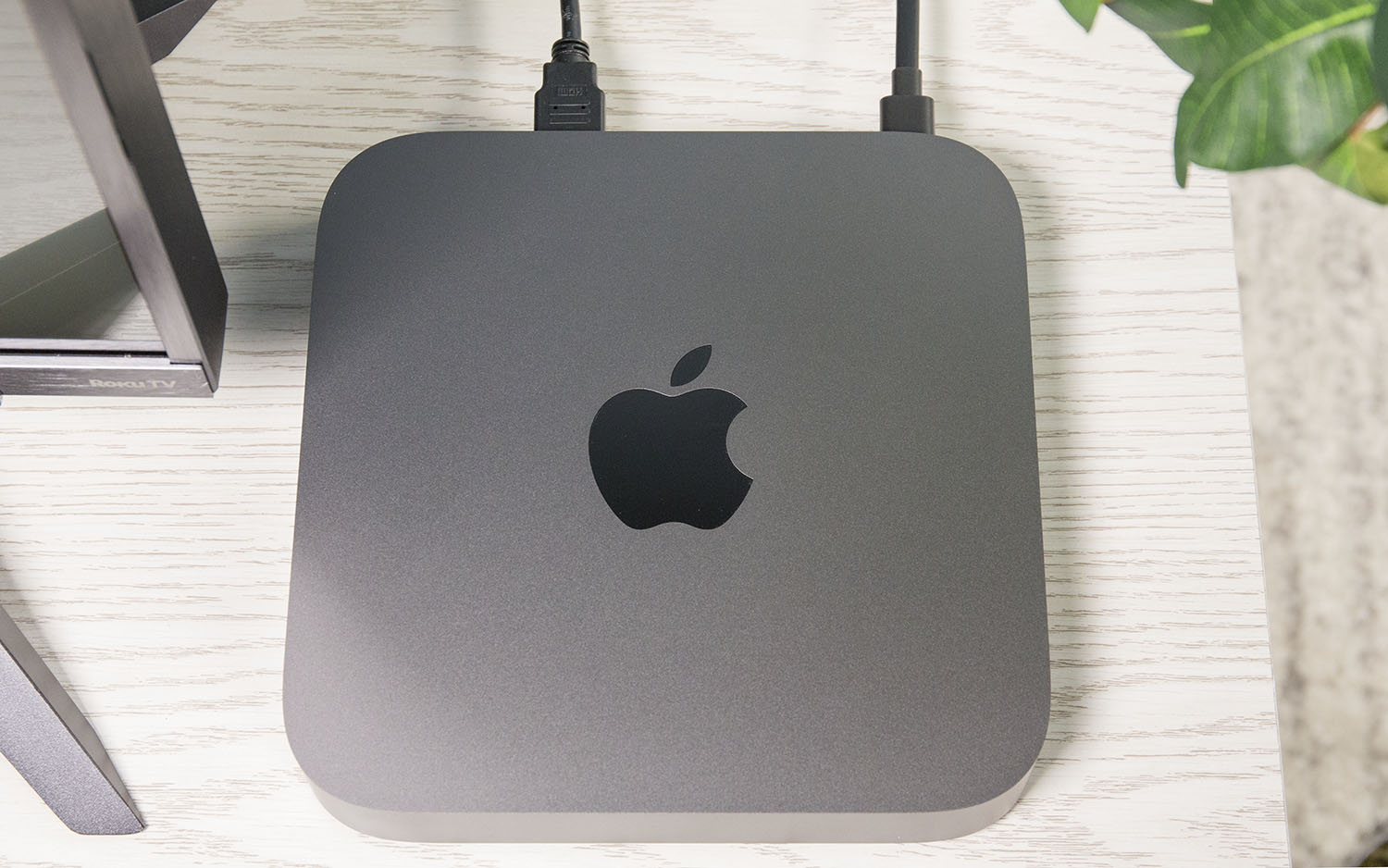
The other ready-to-go configuration starts at $1,099, and boasts a 3.0GHz 6-core Intel Core i5 processor, 8GB of memory and a larger 256GB SSD for storage. (Ed. Note: Apple has changed this to 512GB of storage for the same price.) Both models use the Intel UHD Graphics 630 built into the processor, and there are no options for a built-in discrete GPU. (You can, however, connect an external GPU via the Thunderbolt 3 connections in back.)
Both of these models can be configured further with up to a 6-core Intel Core i7 processor (an extra $200 to 300 depending on which model you started with). You can expand the RAM to 16GB ($200), 32GB ($600) or 64GB ($1,400). You can bump up the storage to larger capacities, with several SSD options.
If you're starting with the base model's 128GB, you can expand to 256GB ($200), 512GB ($400), 1TB ($800) or max out at 2TB ($1,600). You can also upgrade the included Gigabit Ethernet port to 10x Gigabit ($100), which offers a major improvement in speed for local networks and network connected storage. All told, you can spec out a custom configuration that totals $4,199 – a far cry from the $799 base price.
MORE: Top Mac Games
Our recommendation? Unless you need it, you can skip the Ethernet upgrade, but you'll want to be smart when it comes to memory and storage. RAM can be added after the fact, with standard DDR4 memory available for much less than Apple's charging for it. When in doubt, keep the memory low, and upgrade later. Storage, on the other hand, cannot be upgraded, but can be supplemented via Thunderbolt 3.
We'd recommend getting a healthy amount of onboard storage (512GB would be a good amount), and then adding external storage down the road. We'd probably opt for the Core i5 processor option instead of the Core i3 we tested, if only to provide more power. But if you need real muscle for professional use, the hex-core Core i7 is your best bet.
A note for the technically minded: The Core i3 model that we tested doesn't offer either Turbo Boost of Hyper-Threading technology. If you upgrade to a Core i5 model, you'll get Turbo Boost, which lets the clock speed ramp up for short bursts. If you opt for the Core i7 model, you'll get both Turbo Boost and Hyper-Threading for more multithread capability.
Apple Mac mini review: Verdict
One major benefit of Apple's four-year gap between updates is that there's no confusion about the new Mac mini — it's better than any of its predecessors. And if you've been looking for a chance to upgrade from an older model, there's no reason to wait.
It's also much more versatile, with a wide range of configurations that should appeal to home-theater users and media pros alike. And Apple has trumpeted the Mac mini's flexibility for things like building computing clusters, offloading code compiling from a Macbook, or even racking multiple minis together as a server.
Comparing against other mini PCs, the Mac mini 2018 also manages to squeeze exceptional power out of its Intel Core i3 processor, and I'd expect similarly optimized performance from the Core i5 and i7 models.
That said, there are plenty of reasons to choose something different. If you need more graphics horsepower for professional use, the HP Z2 Mini G4 is still our top pick for workstation-grade mini PCs, thanks its Intel Xeon processor and Nvidia Quadro graphics. And if you're looking for something aimed at gaming or office work, then the Intel Hades Canyon NUC and the Lenovo ThinkCentre M710q Tiny might be better fits.
But if you want a compact Mac desktop, a great mini PC for streaming media, or even just an affordable way to jump to the Apple side of the computing world, the Mac mini 2018 is a fantastic choice, boasting great performance, excellent design and great value.
Credit: Tom's Guide
Brian Westover is currently Lead Analyst, PCs and Hardware at PCMag. Until recently, however, he was Senior Editor at Tom's Guide, where he led the site's TV coverage for several years, reviewing scores of sets and writing about everything from 8K to HDR to HDMI 2.1. He also put his computing knowledge to good use by reviewing many PCs and Mac devices, and also led our router and home networking coverage. Prior to joining Tom's Guide, he wrote for TopTenReviews and PCMag.
-
thefella If there are only two memory sockets available, won't each memory DIMM be 32 GB (if maxing to 64 GB)? Is there actually an aftermarket 32 GB stick (having 260-Pin DDR4 SO-DIMM DDR4 2666)?Reply -
bwestover Reply21464215 said:If there are only two memory sockets available, won't each memory DIMM be 32 GB (if maxing to 64 GB)? Is there actually an aftermarket 32 GB stick (having 260-Pin DDR4 SO-DIMM DDR4 2666)?
I've only seen 16GB on the market, but I'd expect 32GB modules to be available soon, if only to address this niche. -
2mrpeabody Crucial and OWC have 32GB SO-DIMMs for the new mini. Crucial's are available now; OWC's have 7 day availability.Reply -
Eaglecreeker I cant decide if some people just get excited by overpaying for things made by apple or if they are hoping there extra 500 bucks per purchase will help the company stay afloat, i bought one of the early Apple TVs and it was about as fast as watching paint dry,, but even then they used nice materials in their products,,, but heck with what they charge most items should come numbered with a gold inlay. I just recently was helping a young relative with a old ipod the little one and had to get re-aquainted with Itunes again,, its really amazing that after years it doesnt look like its ever been updated,,,i hadvlong since changed banks and cities so i had to go back down that rabbit hole,, i remembered soon enough why i left,,,its shocking apple still charges for singles with so much being free these days.Reply -
tommysart Apple gave us long time mini users the middle finger by scrapping the $500 priced mini and jacking the price. So now I'm giving Apple the middle finger. Screw you, Apple.Reply
